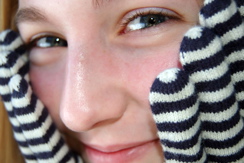 West Michigan winter is in full force. The snowmobiles are out of the garage and full of gas, the skis are down from the attic, dusted, waxed, and ready. Sleds sprinkle the hill, and leave laughing children in their wake. Snowy sports bring out the best of Michigan's winters, until someone gets frostbite.
West Michigan winter is in full force. The snowmobiles are out of the garage and full of gas, the skis are down from the attic, dusted, waxed, and ready. Sleds sprinkle the hill, and leave laughing children in their wake. Snowy sports bring out the best of Michigan's winters, until someone gets frostbite.
Any of the four stages of frostbite can cause severe discomfort and require special attention. The symptoms of this cold-induced ailment are most commonly seen in the deep months of winter, especially among those who spend extended periods of time outdoors. Guard your skin against frostbite this season to avoid skin damage or worse, the loss of digits.
Frost nip is categorized outside of the four stages of frostbite. Numb hands, feet or other areas of skin are a good indication of frost nip–a condition that usually resolves itself once the numb area of the body is warmed. No permanent damage comes from frost nip.
The first stage of frostbite often sinks no deeper than the top layer of skin. Noses and fingers are most commonly affected by the first degree. Pale skin and some swelling indicate the stage but will not cause permanent damage.
Stage two frostbite leaves several small blisters on the affected area. More severe cases of stage two will cause the blistered skin to die and eventually blacken. However, because this stage only affects the top layer, there is a small amount of skin loss.
The third stage of frostbite is indicated by blistering and blackened skin similar to stage two, but the underlying layers of skin are damaged, unlike the previous stages.
The fourth stage of frostbite is the most severe with damage extending to the muscle or bone creating a mummification of the affected area. Those suffering from stage four can lose fingers and toes.
Dr. Steve Cahill oversees the urgent care division at Lakeshore Heath Partners in Holland. He advises against smoking and drinking while exposed to cold temperatures.
"Smoking constricts the blood vessels. If they're smaller, there is no blood supply to the digits," he says.
Alcohol dehydrates the body and makes the body more prone to hypothermia.
Also avoid wearing cotton clothing which stays wet and wicks away body heat, Dr. Cahill says. Instead, wear clothing with nylon lining and wool so that water can escape the skin area. Melting snow and a frigid wind chill can lead to frostbite.
"If you're jetting around fast, the wind can essentially freeze your face. Cover your face and eyes…Don't stay out for extended periods of time," Dr. Cahill says.
The most common areas for frostbite are the ears, nose, cheeks, chin, fingers and toes. If frostbite is suspected, look for areas of white to gray skin, insensitivity, blisters or hard, waxy areas of skin. Immediately move to a warmer location, but avoid putting hands near uncontrollable heat sources like a fire or space heater.
"You don't know the temperature, and in the end you could end up doing more damage," Dr. Cahill says.
Instead, fill a bucket with warm water, test the temperature with an area of skin that is not numb, and slowly warm the affected area.
Dr. Cahill says frostbite is "not uncommon is places in Michigan," especially among young children. If frostbite covers a significant portion of the skin tissue, seek medical attention.
Written by: Erika Fifelski was born and raised in West Michigan, and after a brief stint on the sunrise side, she's home and loving it. Erika enjoys cooking, sewing, vacuuming, and discovering new ways to live sustainably and support local businesses. Photo: Julia Freeman-Woolpert




